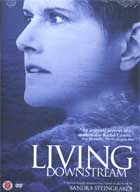
Living Downstream 2010
Distributed by First Run Features, 630 Ninth Avenue, Suite 1213, New York, NY 10036; 212-243-0600
Produced by Chanda Chevannes
Directed by Chanda Chevannes
DVD, color, 85 min.
General Adult
Ecology, Cancer, Water Pollution, Toxic Chemicals, Environmental History
Date Entered: 01/10/2014
Reviewed by Andrew Jenks, California State University, Long BeachOne of the most effective ways to tell a story is through the personal struggles of an individual. This documentary follows the personal and public struggle of the biologist Sandra Steingraber, a bladder cancer survivor. Steingraber gave up a tenure-track job as a biologist to devote her intellectual energies to exposing the link between toxic chemicals in the environment and cancer. Her aim, as an “abolitionist” following in the spirit of the anti-slavery movement, was to make the elimination of environmental toxins a basic human right.
One of the most explosive issues in environmental controversies is proving a direct connection between toxic chemicals dumped into the environment and various cancers. Scientists can only speak in terms of probabilities. It is always possible that a person, regardless of environmental factors, will contract one form of cancer or another. Proving with 100 percent certitude that cancer was caused by environmental factors is therefore impossible. Yet the evidence for the likelihood of such links seems to be mounting. This film raises the issue of environmentally-caused cancer in a highly personal way that is sure to stimulate lively classroom discussion.
The film’s subject, Sandra Steingraber, partly followed the path of the biologist Rachel Carson, whose 1962 Silent Spring in many ways launched the modern environmental movement. Carson’s death in 1964 of breast cancer made her writing about the dangers of environmental toxins even more poignant. Like Carson, Steingraber devoted her science to public enlightenment, forsaking the academic world for the challenge of communicating the science of environmental toxins to laypeople and becoming a scientist/activist. That role disconcerts some scientists who see their job as simply producing the data and letting others decide their moral and public policy dimensions. However, unlike Steingraber, who has survived more than 20 years since her initial diagnosis and treatments, Carson kept her personal struggles with cancer separate from her role as a public scientist.
While the documentary is about cancer and chemical pollutants, it also tells the very personal story of dealing with cancer – a topic that is still taboo, as victims soon discover when they begin their treatments and seek sources of emotional support. Perhaps the biggest challenge faced by cancer victims is answering the question about the origins of their illness. Was it something they did? Was it something in the environment? Was it bad genes? For Steingraber, science became a way to answer that troubling question – and thus a source of personal comfort as well as intellectual stimulation.
For this reviewer, whose non-smoking brother died of lung cancer in 2012, the primitive nature of government investigations into cancer clusters and environmental factors is surprising, especially where poor communities are concerned. More than 50 years since Carson’s book, the state of public health science with regard to environmental causes of cancer seems to have barely developed. Steingraber notes that one government investigation into cancer clusters in her native town of Pekin, Illinois, a center for chemical production as well as chemical pesticides and fertilizers for nearby agribusinesses, concluded that levels of cancer were not unusually high. The investigators simply sent out questionnaires to residents asking them if they had cancer. Those who had died, of course, were unable to fill out the forms – and on that basis the investigators concluded there was no cancer cluster.
This is a moving and lyrical film as well as a comprehensible and convincing presentation of the science of toxins and environmental biology. It does an excellent job of combining the personal story of cancer with the scientific story of the impact of toxins on living organisms. It also relates the history of the use of chemicals, tracing its origins to the secret development and deployment of chemicals in World War II and their widespread use without any understanding of their human and environmental impact in post-World-War II America.